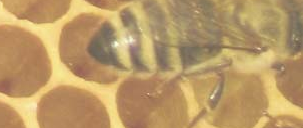
Types of honey refers not to the flavor alone of a honey, but how it is produced. For example, Comb honey, filtered honet, raw honey, pasteurized honey, etc, are all different types of honey. Below is a description of each type of honey and its best uses. If you are looking for descriptions of the many different flavors of honey (sych as, orange bl;ossom, acaia, euculytus, etc., see this page instead)
Nectar Sources
- Blended Honey - a mixture of two or more types of honey from different varieties of flowers. Blended honeys are very common in grovcery stores. They are often blended to produce a uniform flavor, color and viscosity.
- Honeydew Honey - honeydew is a nectar made from "honeydew" the secretions of insects that suck plants. Bees gather the honeydew off the insects. Honeydew honey typically has a strong flavor and many claims are made for its health benefits.
- Monofloral Honey - honey made when the bees collect nectar from a single flower source. Such as a hive located in a Organge tree grove, or in a clover field.
- Organic Honey - In the U.S. the NOP (National Organic
- Polyfloral Honey - the honey comes from the nectar of more than one flower sources. Wildflower honey is usually a polyfloral honey..
Heating and pasteurization
Honey can be raw or heated to destroy pathogens, just like with milk.
- Pasteurized honey - has been heated and strained to kill bacteria such as botulism
- Raw Honey - This is unprocessed honey or honey that hasn’t been heated above 120 degrees. This type of honey may have pollen or beeswax particles.
Filtration
Honey can be filtered to different levels... or not at all. Most people prefer some level of filtration to remove dirt and debris.
- Filtered Honey - honey that has been filtered to the extent
that all or most of the fine particles, pollen grains, air
bubbles, or other materials normally found in suspension, have
been removed. - Strained honey - honey that has been strained to the extent that most of the particles, including comb, wax, propolis, or other defects normally found in honey, have been removed. Grains of pollen, small air bubbles, and very fine particles would not normally be removed. This type of honey is usually a bit cloudy looking due to the natural particals being present.
- Ultrafiltered honey - Ultrafiltered honey is the kind you will find in the supermarket. It has been stripped of its pollen grains and beeswax particles. This honey is heated to allow it to pass through fine filtering equipment. This results in a clear honey. It will crystallize more slowly. This type of honey doesn’t have the valuable enzymes that make honey so special though.
Physical types of honey
- Chunk Honey - This is liquid honey that has a chunk of honeycomb added to the jar.
- Comb Honey - This honey is contained in the honeybee’s wax comb and it makes a beautiful presentation. The comb is actually edible.
- Creamed honey - a blend of one part granulated honey and nine parts liquid honey that is stored at about 57 degrees until it becomes firm.
- Crystallized honey - Crystallized honey is a solid, granulated or crystallized, Looks like an amber sugar
- Liquid honey - Liquid honey is honey that is free from visible crystals.
- Partially crystallized honey - a mixture of liquid honey and crystallized honey.
- Whipped Honey - This is honey that has been deliberately crystallized so that it can be churned. It is very creamy and spreadable at this point. Another name for whipped honey is creamed honey, spun or churned honey.